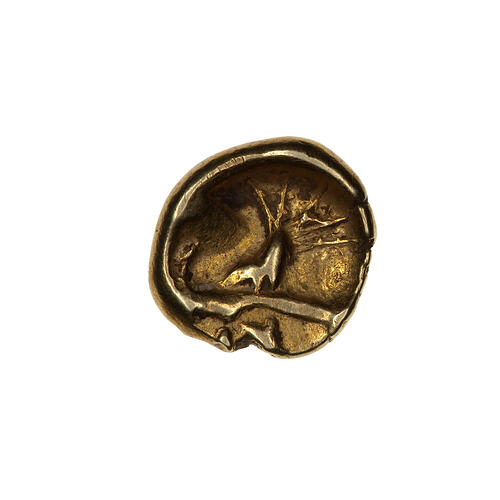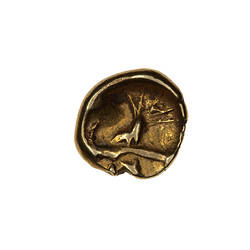Summary
Gold coin; Denomination: 1/4 Stater
This coin is thought to have been struck by a group of Gallo-Belgic invaders who entered Southern England about 80 BC. The date is largely based on the discovery of a worn example of this coin type buried in a hoard during the invasion of Julius Caesar - worn in the 50s therefore struck earlier- about 80 BC.
This coin is from a series termed Gallo-Belgic D. Celtic coins used in Britain are referred to by reference to their place of manufacture, Gallo-Belgic coins were struck in what is today France. The letters A, B etc following the issue designator indicate the chronological order of production as determined by archaeological and coin hoard studies, A being earliest, B next and so on. If an issuing tribe name is known it is added in brackets at the end. This coin was therefore struck in ancient Gaul and was of the type argued to be part of the fourth invasion, or large scale movement of people from France to England. Six such movements are identified from the coins. There is no historical record of these movements although they are suggested in Julius Caesar's commentary on his Gallic wars (see Commentarii de Bello Gallico 2.4, 5.12) when he notes support from Britain and fugitives fleeing to Belgic settlements in Britain. This was one of the reasons for his invasion in 55 and 54 BC.
Obverse Description
Described by Evans as "Two vertical objects like rudely-shaped Es, placed back to back beneath a curved figure like a fish", cinquefoil in the field right.
Reverse Description
A crooked line with tree above and uncertain object below
Edge Description
plain
More Information
-
Collecting Areas
-
Acquisition Information
Transfer from National Gallery of Victoria (NGV), Seaby, B.A. Ltd., 15 Mar 1976
-
Acknowledgement
Purchased, Felton Bequest, 1932
-
Date Issued
circa 80 BC
-
Place & Date Issued
-
Denomination
-
Series
-
Material
Gold
-
Axis
10
-
Classification
-
Category
-
Discipline
-
Type of item
-
Overall Dimensions
11 mm (Outside Diameter), 1.58 g (Weight)
-
Shape
Round
-
References
[Book] Mack, R. P. 1975. The Coinage of Ancient Britain., p. 25, No. 41 Pages
[Book] Evans, John. 1864. The Coins of the Ancient Britons., E.10 Pages
-
Keywords


